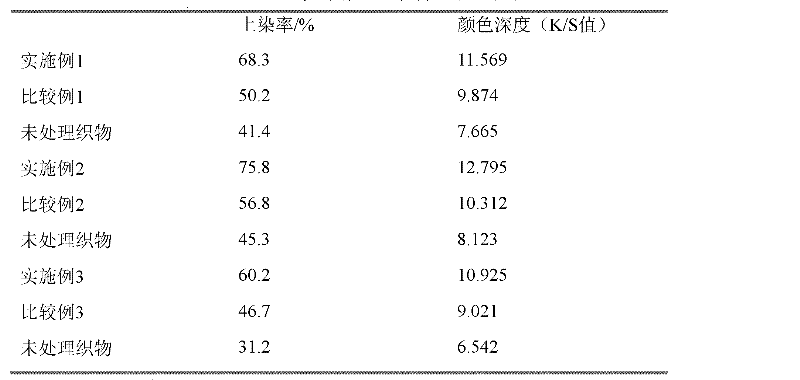A method for improving the dyeing depth of cellulose fiber fabrics with chitosan
A technology for dyeing cellulose fibers and fabrics, applied in dyeing methods, fiber treatment, plant fibers, etc., can solve problems such as fiber strength damage, chitosan shedding, and poor bonding, and achieve improved reactivity, wrinkle resistance, and The effect of improving the dyeing rate
- Summary
- Abstract
- Description
- Claims
- Application Information
AI Technical Summary
Problems solved by technology
Method used
Image
Examples
Embodiment 1
[0026] Alkali pretreatment: immerse 2g of desized, scoured, and bleached cotton fabric in 20% NaOH solution at room temperature, soak for 20 minutes, wash 3 times with water, then soak in 10% glacial acetic acid for 30 minutes, and wash until Neutral, dry at 80°C to obtain alkali pretreated cotton fabric;
[0027] 0.025g chitosan was dissolved in 100mL of citric acid solution with a mass fraction of 5%. After it was completely dissolved, 0.001moL epichlorohydrin was added to obtain a chitosan finishing solution;
[0028] Pad the chitosan finishing solution through alkali pretreated cotton fabric, two dips and two rolls, the excess rate is 70%, and then the mass fraction of padding is 5% NaOH solution, two dips and two rolls, the excess rate is 100%, 85% After drying at 140°C for 3 minutes, washing with water three times to remove non-covalently cross-linked chitosan, drying at 85°C, selecting reactive dyes for conventional dyeing.
Embodiment 2
[0037] Alkali pretreatment: immerse 2g of viscose fabric that has been desized, boiled and bleached in 10% NaOH solution at room temperature, soak for 10 minutes, wash 4 times with water, then soak in 5% glacial acetic acid for 45 minutes, wash with water To neutral, dry at 85°C to obtain alkali pretreated viscose fabric;
[0038] Dissolving 0.05g chitosan in 100mL of tartaric acid solution with a mass fraction of 10%, after it was completely dissolved, added 0.002moL epichlorohydrin to obtain a chitosan finishing solution;
[0039] Padding the chitosan finishing liquid through the viscose fabric pretreated by alkali, two dipping and two rolling, the excess rate is 80%, and then the mass fraction of padding is 10% NaOH solution, two dipping and two rolling, the excess rate is 80%, After drying at 80°C, bake at 150°C for 2 minutes, then wash 4 times with water to remove non-covalently cross-linked chitosan, and dry at 80°C, choose direct dyes for conventional dyeing.
Embodiment 3
[0048] Alkali pretreatment: immerse 2 g of desized, scorched and bleached hemp fabric at room temperature in 30% NaOH solution, soak for 20 minutes, wash 5 times with water, then soak in 8% glacial acetic acid for 35 minutes, and wash until Neutral, drying at 85°C to obtain alkali-pretreated hemp fabric;
[0049] 0.125g chitosan is dissolved in 100mL mass fraction and is 8% citric acid, tartaric acid mixed solution (the mol ratio of citric acid and tartaric acid is 3: 1), after it dissolves completely, add 0.005mol epichlorohydrin, Prepare chitosan finishing solution;
[0050] Padding the chitosan finishing solution on the hemp fabric pretreated by alkali, two dipping and two rolling, the excess rate is 100%, and then the mass fraction of padding is 20% NaOH solution, two dipping and two rolling, the excess rate is 90%, 85% After drying at 160°C for 1 min, then washing 5 times with water to remove non-covalently cross-linked chitosan, after drying at 85°C, choose soluble vat ...
PUM
| Property | Measurement | Unit |
|---|---|---|
| concentration | aaaaa | aaaaa |
Abstract
Description
Claims
Application Information
 Login to View More
Login to View More - R&D
- Intellectual Property
- Life Sciences
- Materials
- Tech Scout
- Unparalleled Data Quality
- Higher Quality Content
- 60% Fewer Hallucinations
Browse by: Latest US Patents, China's latest patents, Technical Efficacy Thesaurus, Application Domain, Technology Topic, Popular Technical Reports.
© 2025 PatSnap. All rights reserved.Legal|Privacy policy|Modern Slavery Act Transparency Statement|Sitemap|About US| Contact US: help@patsnap.com



